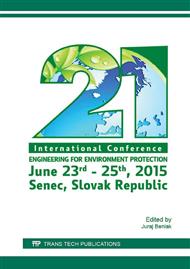p.95
p.103
p.109
p.115
p.122
p.131
p.137
p.144
p.152
Using of Ferrous Chloride in Anaerobic Digestion of a Substrate with High Sulphur Content
Abstract:
Possibilities of anaerobic processing of substrates rich in sulphur were studied. High concentrations of sulphur cause problems when contained in biogas, as well as inhibition by sulphides in anaerobic processes. The impact of ferrous chloride on anaerobic processes, directly dosed to the anaerobic reactor was studied. This sulphur removal method is commonly known, though the objective of our study was to identify problems when it is applied on substrates rich in sulphur. Waste biomass from cystine production was used as substrate, which is produced in large quantities (17000 t/y) by Biotika, a.s. Slovenská Ľupča and requires processing; sulphur content range from 4 up to 5 % in the biomass. Specific biogas production was 0.410 m3/kg COD i.e. 0.737 m3/kg VSS, while 77 % sulphide inhibition occurred after several dose repetitions. Inhibition decreased to 25.4 % during long-term processing of cystine biomass in a mixed anaerobic reactor. Ferrous chloride dosing, however, resulted in high excess sludge generation, lower organic content in the sludge and high concentration of dissolved inorganic salts. These factors may lead to secondary problems in long-term processing of cystine biomass.
Info:
Periodical:
Pages:
122-127
Citation:
Online since:
April 2016
Price:
Сopyright:
© 2016 Trans Tech Publications Ltd. All Rights Reserved
Share:
Citation:


